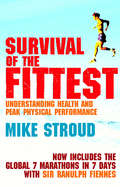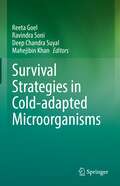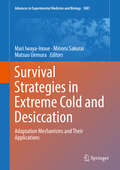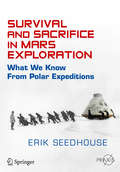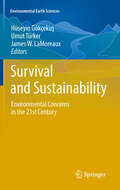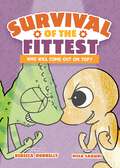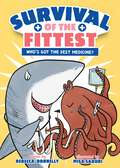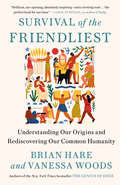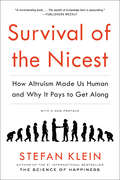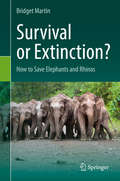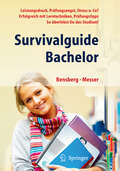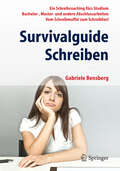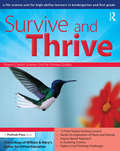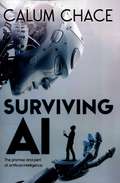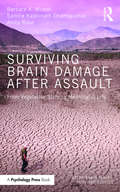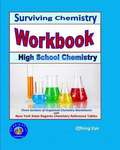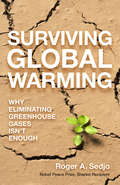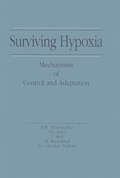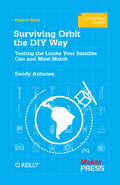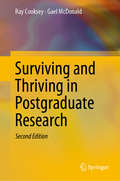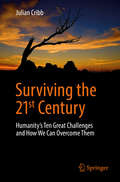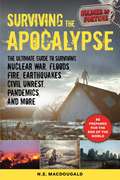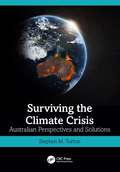- Table View
- List View
Survival Of The Fittest: The Anatomy of Peak Physical Performance
by Mike StroudDiscover the secrets of how to perform at your best in 2019In this fascinating book based soundly in medical science, Mike Stroud - of BBC Television's The Challenge and SAS: Are You Tough Enough? - sets out the genetics, diet and exercise that enable humans to perform at their peak. Dr Stroud - polar explorer, practising hospital physician, and a former adviser to the Ministry of Defence - analyses individual feats of survival and athletic prowess that illustrate the way the body functions at its best. He dissects his own challenging experiences of crossing Antarctica with Ranulph Fiennes, running marathons in the Sahara and participating in gruelling cross-country endurance races in the United States and gives some tips on how to stay fit for life for those of us who find walking the dog an endurance challenge...This revised edition includes the story of Dr Stroud and Sir Ranulph Fiennes' incredible 2003 global marathon challenge - seven marathons on seven continents in seven days - in aid of the British Heart Foundation.'The ultimate sporting diet documented in mouth-watering detail' The Times
Survival Strategies in Cold-adapted Microorganisms
by Reeta Goel Ravindra Soni Deep Chandra Suyal Mahejibin KhanExtremophiles have unique physiological properties, thus considered to be ideal candidates for industrial development. This book present concepts on cold-adapted microorganisms, centered on four different aspects - (i) diversity of cold adapted microbes (ii) their ecology, physiology and metabolism (iii) omics research in the field and (iv) their potential applications. This volume collates the recent developments and innovations with respect to these microorganisms. This book is meant for researchers, biochemists, industries, and government agencies interested in cold active microbes and their products. Also, would be of interest to NGOs and progressive farmers which are working for higher altitude ecosystems throughout the globe.
Survival Strategies in Extreme Cold and Desiccation: Adaptation Mechanisms And Their Applications (Advances in Experimental Medicine and Biology #1081)
by Mari Iwaya-Inoue Minoru Sakurai Matsuo UemuraThis book comprehensively describes biological phenomena, adaptation mechanisms, and strategies of living organisms to survive under extremely cold or desiccated conditions at molecular, cellular, and organ levels. It also provides tremendous potential for applications of the findings to a wide variety of industries. The volume consists of three parts: Part 1, Adaptation Mechanisms of Cold, and Part 2, Adaptation Mechanisms of Desiccation, collect up-to-date research on mechanisms and strategies of living organisms such as sleeping chironomids, polar marine fishes, hibernating mammals, bryophytes, dormant seeds, and boreal plants to survive under extreme cold and desiccated conditions at molecular, cellular, and organ levels. Part 3, Application Technologies from Laboratory to Society, covers various applications to a wide variety of industries such as the medical, food, and agricultural and life science industries. For example, biological knowledge of how plants and animals survive under cold, drought, and desiccated conditions may provide a hint on how we can improve crop production in a very fragile environment in global climate change. Unique molecules that protect cells during desiccation and freezing such as trehalose and antifreeze protein (AFP) have potential for use to preserve cells, tissues, and organs for the long term under very stable conditions. In addition, the current progress of supercooling technology of cells may lead us to solve problems of cellular high sensitivity to freezing injury, which will dramatically improve the usability of these cells. Furthermore, knowledge of water substitution and glass formation as major mechanisms for formulation designs and new drying technologies will contribute to the development of food preservation and drug delivery systems under dry conditions. Written by contributors who have been conducting cutting-edge science in related fields, this title is recommended to a wide variety of readers who are interested in learning from such organisms their strategies, mechanisms, and applications, and it will inspire researchers in various disciplines.
Survival Strategies: Cooperation and Conflict in Animal Societies
by Raghavendra GadagkarDid you know that Tasmanian hens have two husbands? That cellular slime molds commit suicide? That vampire bats will share food with hungry fellow bats and that hanuman langurs commit infanticide? Why creatures great and small behave in such fascinating and seemingly perplexing ways is explained in this delightful account of the evolutionary foundations of animal social behavior. Only in recent years have biologists and ethologists begun to apply careful evolutionary thinking to the study of animal societies--and with spectacular results. This book presents the choicest of these findings, with a remarkable wealth of insights into the myriad strategies that animals have developed to perpetuate their kind. In an irresistible style, Raghavendra Gadagkar explores the strategies of cooperation and conflict adopted by animals--from the lordly lion to the primitive wasp worker--as they choose mates, raise their young, communicate with others, and establish the division of labor necessary to feed and protect the group and safeguard their territory. Whether focusing on the birds or the bees, this book offers both superb descriptions and lucid explanations of many different behaviors encountered in the animal world: why a ground squirrel will sound an alarm--even risk its own safety--to warn fellow squirrels of impending danger; why weaver ant larvae donate silk for nest building; why house mice raise their offspring in a communal nursery; and how animals can recognize the relatives they want to favor--or avoid. Illustrated with both photographs and explanatory diagrams, this expert and inviting tour of the social world of animals will inform and charm anyone curious about the motivations behind the amazing range of activity in the animal kingdom.
Survival and Sacrifice in Mars Exploration
by Erik SeedhouseWith current technology, a voyage to Mars and back will take three years. That's a lot of time for things to go wrong. But sooner or later a commercial enterprise will commit itself to sending humans to Mars. How will the astronauts survive? Some things to consider are: ith current technology, a voyage to Mars and back will take three years. That's a lot of time for things to go wrong. But sooner or later a commercial enterprise will commit itself to sending humans to Mars. How will the astronauts survive? Some things to consider are: * Who decides what medical resources are used for whom? Who decides what medical resources are used for whom? * What is the relative weight of mission success and the health of the crew? What is the relative weight of mission success and the health of the crew? * Do we allow crewmembers to sacrifi ce their lives for the good of the mission? Do we allow crewmembers to sacrifi ce their lives for the good of the mission? * And what if a crewmember does perish? Do we store the body for return to Earth or give the member a burial in space? Questions like these, and hundreds of others, have been explored by science fi ction, but scant attention has been paid by those designing missions. Fortunately, the experience gained in polar exploration more than 100 years ago provides crews and mission planners with a framework to deal with contingencies and it is this that forms the core of this book. Why the parallels between polar and space exploration? Because polar exploration offers a better analogy for a Mars mission today than those invoked by the space community. Although astronauts are routinely compared to Lewis and Clark, Mars-bound astronauts will be closer in their roles to polar explorers. And, as much as space has been described as a New Frontier, Mars bears greater similarity to the polar regions, which is why so much can be learned from those who ventured there. And what if a crewmember does perish? Do we store the body forreturn to Earth or give the member a burial in space? Questions like these, and hundreds of others, have been explored by science fi ction, but scant attention has been paid by those designing missions. Fortunately, the experience gained in polar exploration more than 100 years ago provides crews and mission planners with a framework to deal with contingencies and it is this that forms the core of this book. Why the parallels between polar and space exploration? Because polar exploration offers a better analogy for a Mars mission today than those invoked by the space community. Although astronauts are routinely compared to Lewis and Clark, Mars-bound astronauts will be closer in their roles to polar explorers. And, as much as space has been described as a New Frontier, Mars bears greater similarity to the polar regions, which is why so much can be learned from those who ventured there.
Survival and Sustainability
by James W. Lamoreaux Umut Türker Hüseyin GökçekusThe International Conference on Environment: Survival and Sustainability, held at the Near East University, Nicosia, Northern Cyprus 19-24 February 2007, dealt with environmental threats and proposed solutions at all scales. The 21 themes addressed by the conference fell into four broad categories; Threats to Survival and Sustainability; Technological Advances towards Survival and Sustainability; Activities and Tools for Social Change; Defining Goals for Sustainable Societies. Activities and tools that move the society towards greater sustainability were emphasized at the conference. These included environmental law and ethics, environmental knowledge, technology and information systems, media, environmental awareness, education and lifelong learning, the use of literature for environmental awareness, the green factor in politics, international relations and environmental organizations. The breadth of the issues addressed at the conference made clear the need for greatly increased interdisciplinary and international collaboration the survival and sustainability concept. The exchanges at the conference represent a step in this direction.
Survival of the Fittest (Survival of the Fittest #1)
by Rebecca DonnellyIn this high-interest full-color graphic novel chapter book, embark on an engineering extravaganza and discover all that animals can do in a science competition!7 fierce animal competitors2 shark judges1 winnerWho will come out on top?Survival of the Fittest: the game show where animal contestants pitch the latest and greatest in scientific innovation to a panel of shark judges! Animals of all sizes and skills compete to see who can come up with the most useful, most creative, most brilliant design for a product based on something that exists in the natural world. Today's theme is: engineering.Filled with interesting information, awesome visuals, and funny dialogue, this new series by nonfiction maven Rebecca Donnelly is Shark Tank made literal. Swim along - and try not to get chomped by the Chomp! Buzzer.
Survival of the Fittest: Who's Got the Best Medicine? (Survival of the Fittest)
by Rebecca DonnellyIn this second installment of this full-color graphic novel chapter book, explore medical marvels and discover all that animals can do in a science competition!Welcome back to Survival of the Fittest! Here, animals of all sizes and skills compete to see who can come up with the most useful and clever design for a product based on something in the natural world. Today’s theme is: Medical Marvels!Dive in with Mosquito, Sea Urchin, Octopus, and more as they present inventions inspired by their own unique anatomy. From sticky suction cups to water-repellent skin, who will impress the sharks the most?
Survival of the Friendliest: Understanding Our Origins and Rediscovering Our Common Humanity
by Brian Hare Vanessa WoodsA powerful new theory of human nature suggests that our secret to success as a species is our unique friendliness&“Brilliant, eye-opening, and absolutely inspiring—and a riveting read. Hare and Woods have written the perfect book for our time.&”—Cass R. Sunstein, author of How Change Happens and co-author of Nudge For most of the approximately 300,000 years that Homo sapiens have existed, we have shared the planet with at least four other types of humans. All of these were smart, strong, and inventive. But around 50,000 years ago, Homo sapiens made a cognitive leap that gave us an edge over other species. What happened? Since Charles Darwin wrote about &“evolutionary fitness,&” the idea of fitness has been confused with physical strength, tactical brilliance, and aggression. In fact, what made us evolutionarily fit was a remarkable kind of friendliness, a virtuosic ability to coordinate and communicate with others that allowed us to achieve all the cultural and technical marvels in human history. Advancing what they call the &“self-domestication theory,&” Brian Hare, professor in the department of evolutionary anthropology and the Center for Cognitive Neuroscience at Duke University and his wife, Vanessa Woods, a research scientist and award-winning journalist, shed light on the mysterious leap in human cognition that allowed Homo sapiens to thrive. But this gift for friendliness came at a cost. Just as a mother bear is most dangerous around her cubs, we are at our most dangerous when someone we love is threatened by an &“outsider.&” The threatening outsider is demoted to sub-human, fair game for our worst instincts. Hare&’s groundbreaking research, developed in close coordination with Richard Wrangham and Michael Tomasello, giants in the field of cognitive evolution, reveals that the same traits that make us the most tolerant species on the planet also make us the cruelest. Survival of the Friendliest offers us a new way to look at our cultural as well as cognitive evolution and sends a clear message: In order to survive and even to flourish, we need to expand our definition of who belongs.
Survival of the Nicest: How Altruism Made Us Human and Why It Pays to Get Along
by Stefan KleinAward-winning, international bestselling science writer Stefan Klein explores the benefits of altruism on humanity in Survival of the Nicest.The phrase “survival of the fittest” conjures an image of the most cutthroat individuals rising to the top. But Stefan Klein, author of The Science of Happiness, makes the startling assertion that altruism is the key to lasting personal and societal success. In fact, altruism defines us: Natural selection favored those early humans who cooperated in groups, and with survival more assured, our altruistic ancestors were free to devote brainpower to developing intelligence, language, and culture—our very humanity. Klein’s groundbreaking findings lead him to a vexing question: If we’re really hard-wired to act for one another’s benefit, why aren’t we all getting along? He believes we’ve learned to mistrust our instincts because success is so often attributed to selfish ambition, and with an extraordinary array of material—current research on genetics and the brain, economics, social psychology, behavioral and anthropological experiments, history, and modern culture—he makes the case that generosity for its own sake remains the best way to thrive.“Stefan Klein, an enticing storyteller, marshals the evidence for the value of altruism—not only to one’s family but, much more interestingly, to one’s self and one’s tribe. Altruism is truly contagious!” —Roald Hoffman, Nobel Laureate“A scholarly tour de force about why generosity makes good sense, Survival of the Nicest is also compulsively readable. Klein argues convincingly that helping others is one of the best things we can do for ourselves.” —Elizabeth Svoboda, author of What Makes a Hero?: The Surprising Science of Selflessness
Survival or Extinction?: How to Save Elephants and Rhinos
by Bridget MartinWritten with passion for anyone interested in seeing an end to the illegal trade in elephant ivory and rhino horn, this book shows how, by working together, people all over the world who care about these animals are gradually bringing about change for the better. It takes an overview of how the current situation came to pass by exploring poaching and its devastating consequences and the pivotal role of organized crime. The discussion of how matters are starting to improve covers the investigation and monitoring of ivory markets, sustainable uses and the key role of local communities.Enforcement of the law is vital in this story. Enter the enforcers, the technology they use to defeat the poachers and the evidence they require to prosecute offenders. Cases, some deeply shocking, are included, as well as a number of fascinating case studies, while the exploits of organized crime gangs make lively, as well as disturbing reading. Throughout the message is clear. We can and must save these animals from extinction.
Survival-Guide fürs Life-Science-Studium
by Angela MaginDu planst ein Studium im Bereich Biomedizin, Molekularbiologie, Life Sciences und Co. oder hast gerade angefangen zu studieren – und hast viele Fragen? Vor allem dazu, was in deinem Studium auf dich zukommt? Hier erfährst du, was an der Hochschule von dir erwartet wird! Von deinen ersten Schritten ins Labor über die Auswertung von Daten, das Verfassen von Praktikumsprotokollen und die Arbeit mit wissenschaftlicher Literatur bis hin zu deinem eigenen, kleinen Forschungsprojekt in der Abschlussarbeit begleitet dich dieses Buch durch dein gesamtes Studium. Es zeigt dir, worauf du besonders achten musst, und erklärt dir das, was in deinen Vorlesungen oft zu kurz kommt: Wie Wissenschaft in der Praxis funktioniert.
Survivalguide Bachelor. Leistungsdruck, Prüfungsangst, Stress und Co? Erfolgreich mit Lerntechniken, Prüfungstipps ... so überlebst Du das Studium
by Gabriele Bensberg Jürgen MesserDurch das Bachelor-Studium hat sich das Studieren verändert. Häufige Prüfungen und überfrachtete Studienpläne setzen Studierende unter Druck, die Prüfungsangst nimmt zu. Die Autoren leiten eine Beratungsstelle des Studentenwerks, sie kennen diese Nöte. In ihrem Ratgeber zeigen sie auf einfühlsame und humorvolle Weise, wie sich Studierende physisch und psychisch stärken können: durch Bewegung, Entspannungstechniken und Genuss. Sie vermitteln Strategien für effektives Lernen, für das Stressmanagement sowie Hilfen zur Bewältigung der Prüfungsangst.
Survivalguide Schreiben: Ein Schreibcoaching fürs Studium Bachelor-, Master- und andere Abschlussarbeiten Vom Schreibmuffel zum Schreibfan!
by Gabriele BensbergWenn Studierenden das Schreiben wissenschaftlicher Texte schwer fällt, kann es für sie zum Fluch werden - bis hin zur Angst, an der Abschlussarbeit zu scheitern. Die Autorin, erfahrene Studierenden-Beraterin und Schreibcoach, zeigt in diesem Buch, wie Studierende aufbauend auf ihren alltäglichen Schreibaktivitäten im Internet eine Brücke zum wissenschaftlichen Schreiben schlagen können. Das Buch bietet Handlungsanleitungen und Problemlösungen für alle Phasen der wissenschaftlichen Arbeit und dient darüber hinaus als psychologischer Begleiter.
Survive and Thrive: A Life Science Unit for High-Ability Learners in Grades K-1
by College of William & Mary's Centre for Gifted ChildrenSurvive and Thrive, a life science unit for grades K-1, provides students an opportunity to study animals, their characteristics, and their natural environments. The overarching concept of change guides students as they use webcams to distinguish the features of animals, determine their basic needs to survive, and observe animals in their habitats.Survive and Thrive was developed by the Center for Gifted Education at The College of William and Mary to offer advanced curriculum supported by years of research. The Center's materials have received national recognition from the United States Department of Education and the National Association for Gifted Children, and they are widely used both nationally and internationally.Each of the books in this series offers curriculum that focuses on advanced content and higher level processes. The science units contain simulations of real-world problems, and students experience the work of real science by using data-handling skills, analyzing information, and evaluating results. The mathematics units provide sophisticated ideas and concepts, challenging extensions, higher order thinking skills, and opportunities for student exploration based on interest. These materials are a must for any teacher seeking to challenge and engage learners and increase achievement.Grades K-1
Surviving AI: The Promise and Peril of Artificial Intelligence
by Calum ChaceArtificial intelligence is our most powerful technology, and in the coming decades it will change everything in our lives. If we get it right it will make humans almost godlike. If we get it wrong... well, extinction is not the worst possible outcome. "Surviving AI" is a concise, easy-to-read guide to what's coming, taking you through technological unemployment (the economic singularity) and the possible creation of a superintelligence (the technological singularity). Here's what some of the leading thinkers in the field have to say about it: A sober and easy-to-read review of the risks and opportunities that humanity will face from AI. Jaan Tallinn - co-founder of Skype Understanding AI - its promise and its dangers - is emerging as one of the great challenges of coming decades and this is an invaluable guide to anyone who's interested, confused, excited or scared. David Shukman - BBC Science Editor We have recently seen a surge in the volume of scholarly analysis of this topic; Chace impressively augments that with this high-quality, more general-audience discussion. Aubrey de Grey - CSO of SENS Research Foundation; former AI researcher It's rare to see a book about the potential End of the World that is fun to read without descending into sensationalism or crass oversimplification. Ben Goertzel - chairman of Novamente LLC Calum Chace is a prescient messenger of the risks and rewards of artificial intelligence. In "Surviving AI" he has identified the most essential issues and developed them with insight and wit - so that the very framing of the questions aids our search for answers. Chace's sensible balance between AI's promise and peril makes "Surviving AI" an excellent primer for anyone interested in what's happening, how we got here, and where we are headed. Kenneth Cukier - co-author of "Big Data" If you're not thinking about AI, you're not thinking. "Surviving AI" combines an essential grounding in the state of the art with a survey of scenarios that will be discussed with equal vigor at cocktail parties and academic colloquia. Chris Meyer - author of"Blur," "It's Alive," and "Standing on the Sun" The appearance of Calum Chace's book is of some considerable personal satisfaction to me, because it signifies the fact that the level of social awareness of the rise of massively intelligent machines has finally reached the mainstream. If you want to survive the next few decades, you cannot afford NOT to read Chace's book. Prof. Dr. Hugo de Garis - former director of the Artificial Brain Lab, Xiamen University, China "Surviving AI" is an exceptionally clear, well-researched and balanced introduction to a complex and controversial topic, and is a compelling read to boot. Sean O hEigeartaigh -executive director of Cambridge Centre for the Study of Existential Risk In"Surviving AI," Calum Chace provides a marvellously accessible guide to the swirls of controversy that surround discussion of what is likely to be the single most important event in human history--the emergence of artificial superintelligence. Throughout, "Surviving AI" remains clear and jargon-free. David Wood - chair of London Futurists Artificial intelligence is the most important technology of our era. Technological unemployment could force us to adopt an entirely new economic structure, and the creation of superintelligence would be the biggest event in human history. "Surviving AI" is a first-class introduction to all of this. Brad Feld - co-founder of Techstars"
Surviving Brain Damage After Assault: From Vegetative State to Meaningful Life (After Brain Injury: Survivor Stories)
by Barbara A. Wilson Samira Kashinath Dhamapurkar Anita RoseAt the age of twenty eight Gary was assaulted by a gang with baseball bats and a hammer, resulting in several skull fractures and severe brain damage. For nineteen months he had little awareness of his surroundings before he started to show some recovery. This inspirational book documents his exceptional journey. The book presents a series of interviews with Gary, his mother Wendie, who never gave up, the medical team who initially treated him, and the therapists who worked with him over a period of three years. Through their testimony we learn about the devastating effects which can follow a serious assault to the head, and the long process of recovery over several years. With specialist rehabilitation and continuing family support Gary has exceeded expectations and, apart from some minor physical problems, he is now a normal young man. Surviving Brain Damage after Assault shows that, contrary to popular belief, considerable gains can be made by people who have experienced a long period of reduced consciousness. The book will be of great value to all professionals working in rehabilitation - psychologists, speech and language therapists, occupational therapists, social workers and rehabilitation doctors, and to people who have sustained a brain injury and their families.
Surviving Chemistry Workbook: High School Chemistry (2015 Revision)
by Effiong EyoNewly revised for 2015. With New York State Regents Chemistry - The Physical Setting. A Highly organized workbook for every chemistry classrooms. With Four sections of chemistry work: Worksheets, Multiple Choices, and Constructed Responses. Student Benefits: Work on question sets for each concept you are learning. Test and evaluate your understanding of each concept. Well organized and less confusing problem sets
Surviving Global Warming: Why Eliminating Greenhouse Gases Isn't Enough
by Roger A. SedjoThis provocative and important overview of the challenges of and possible approaches to climate change by an expert and shared recipient of a Nobel Peace Prize is essential reading for policy makers, climate scientists, and lay persons alike.Though the Paris Agreement on climate change was a significant achievement, most authorities agree that its measures to reduce greenhouse-gas emissions will be insufficient to offset the forecasted increase in global warming. Even in the unlikely case of ideal compliance, the Earth will still experience major climate-driven damages. Given this reality, climate expert Roger A. Sedjo argues in this book that a Plan B is required. He makes a compelling case that doing more of the same, by focusing only on the mitigation plan of the Paris Agreement, will leave humanity increasingly vulnerable; instead, we must also begin planning adaptation strategies--Plan B--which enable societies to anticipate and protect against the worst effects of inevitable climate change. The author examines several areas where environmental damage could be severe. Sea-level rise is a major concern and measures could be, and in some cases are now being, undertaken to protect coastal areas. The author also addresses the need for more robust action to ward off the likely decline in agricultural productivity, destruction of forests and biodiversity, and the impact of natural catastrophes like hurricanes made worse by climate change. In addition, he considers geo-engineering strategies, such as atmospheric reflectivity, which may play a role in lessening the impact of global warming.
Surviving Hypoxia: Mechanisms of Control and Adaptation
by Peter L. Lutz Peter W. Hochachka Thomas J. Sick Myron RosenthalSurviving Hypoxia: Mechanisms of Control and Adaptation is a synthesis of findings and thoughts concerning hypoxia. The thermodynamics of hypoxia are discussed in detail, including acid-base balance and self-pollution resulting from the accumulation of anaerobic end-products. The book focuses on descriptions and discussions of common facets, contrasting solutions in a variety of physiological hypoxia defense strategies, including those shown by plants, invertebrates, and vertebrates. Special treatment is given to the distinctive problems that hypoxia presents to vulnerable organs such as the kidney, liver, and brain. It also addresses pathological events in addition to protective mechanisms. Clinical implications of basic research are examined in the book, which provides new insights into underlying pathological processes occuring in hypoxic-induced organ failure and indicates new paths for successful clinical intervention. Surviving Hypoxia: Mechanisms of Control and Adaptation is an excellent reference for all researchers interested in the physiological effects of hypoxia, underlying pathological events, and protective mechanisms.
Surviving Orbit the DIY Way: Testing the Limits Your Satellite Can and Must Match
by Sandy AntunesIs your picosatellite ready for launch? Can it withstand rocket thrusts and the vacuum of space? This do-it-yourself guide helps you conduct a series of hands-on tests designed to check your satellite’s readiness. Learn precisely what the craft and its electronic components must endure if they’re to function properly in Low Earth Orbit.The perfect follow-up to DIY Satellite Platforms (our primer for designing and building a picosatellite), this book also provides an overview of what space is like and how orbits work, enabling you to set up the launch and orbit support you’ll need.Go deep into the numbers that describe conditions your satellite will faceLearn how to mitigate the risks of radiation in the ionospherePick up enough formal systems engineering to understand what the tests are all aboutBuild a thermal vacuum chamber for mimicking environment of spaceSimulate the rocket launch by building and running a vibration shake testUse a homebuilt centrifuge to conduct high G-force testsGet guidelines on scheduling tests and choosing an appropriate lab or clean room
Surviving and Thriving in Postgraduate Research
by Ray Cooksey Gael McDonaldThis handbook provides an in-depth exploration of the entire journey of postgraduate research in the social and behavioural sciences, from enrolment to its culmination in the form of a thesis, dissertation or portfolio, and beyond. It is written in an accessible and example-rich style, offering practical and concrete advice in virtually all areas. It also includes references to additional resources and websites, and each chapter features key recommendations for improving the postgraduate research experience. The book addresses not only research-related aspects (e.g. supervisors; selecting your guiding assumptions; contextualising, framing and configuring research; reviewing literature; sampling; writing proposals; ethics and academic integrity; selecting a data gathering strategy; surviving your thesis/dissertation/portfolio examination; and publishing), but also questions concerning how to integrate, manage, and balance the research journey in the context of the postgraduate student’s broader life-world (e.g. skill development and supervisor relations; effective time and project management; a healthy work–life balance; maintaining motivation; and dealing with criticism). The book adopts an explicitly pluralist perspective on postgraduate research, moving beyond mixed methods thinking, and offers concrete examples from postgraduate students’ real-world experiences.
Surviving the 21st Century: Humanity's Ten Great Challenges and How We Can Overcome Them
by Julian CribbThe book explores the central question facing humanity today: how can we best survive the ten great existential challenges that are now coming together to confront us? Besides describing these challenges from the latest scientific perspectives, it also outlines and integrates the solutions, both at global and individual level and concludes optimistically. This book brings together in one easy-to-read work the principal issues facing humanity. It is written for the two next generations who will have to deal with the compounding risks they inherit, and which flow from overpopulation, resource pressures and human nature. The author examines ten intersecting areas of activity (mass extinction, resource depletion, WMD, climate change, universal toxicity, food crises, population and urban expansion, pandemic disease, dangerous new technologies and self-delusion) which pose manifest risks to civilization and, potentially, to our species’ long-term future. This isn’t a book just about problems. It is also about solutions. Every chapter concludes with clear conclusions and consensus advice on what needs to be done at global level —but it also empowers individuals with what they can do for themselves to make a difference. Unlike other books, it offers integrated solutions across the areas of greatest risk. It explains why Homo sapiens is no longer an appropriate name for our species, and what should be done about it.
Surviving the Apocalypse: The Ultimate Guide to Surviving Nuclear War, Floods, Fire, Earthquakes, Civil Unrest, Pandemics, and More (Soldier Of Fortune Ser.)
by N. E. MacDougaldThe Apocalypse could arrive at any moment, but with Surviving the Apocalypse, you'll be well-prepared and well-trained enough to survive any disaster—even the end of the world as we know it. Being prepared for what&’s out there is important—you have to know what to do when everything falls apart. Knowing how to survive the end of the world as we know it will prepare you for anything and everything that could possibly go wrong. From packing the proper survival kit, to surviving on the battlefield, being physically fit, and coping in the event of a socio-economic collapse, Soldier of Fortune magazine, along with N. E. MacDougald, will make sure that you&’re never caught off-guard in any situation, from natural and economic disasters to pandemics and civil unrest—even nuclear war. The purpose of this book is to provide the reader with real-world, practical information that will help them to not only survive, but thrive during a period that is likely not just another downturn in the economic cycle, but according the many experts, instead the beginning of a long downward slide, and possibly the very peak in our 10,000-year experiment of civilization. While you may not plan on being in a war zone, you never know what will happen, so the best thing to always do is be prepared. Whether it's learning how to barter and haggle, how to get the proper camouflage, or how to choose the right weapon for any situation, MacDougald and Surviving the Apocalypse will give you the training and knowledge that goes into surviving any and every dangerous situation imaginable.
Surviving the Climate Crisis: Australian Perspectives and Solutions
by Stephen M. TurtonThis is the first textbook to adopt an integrated perspective of climate change in Australia, drawing on research from the latest Intergovernmental Panel on Climate Change (2021, 2022) Sixth Assessment Reports to make it the most up-to-date resource available. It fills a knowledge gap in an ever-increasing hot topic for the country, its people, economy and environment. Australia has been identified by a number of respected sources as a ‘climate change hotspot’, with all major sectors of the economy considered vulnerable or highly vulnerable to the anticipated adverse impacts of climate change. The chief industry sectors examined in this book include energy, transportation, manufacturing, agriculture, fisheries, forestry, tourism and mining. Other chapters focus on other key thematic areas, such as protected areas and world heritage sites (including their natural and cultural values), coastal and island environments, biosecurity, biodiversity and ecosystem services, human health, water resources, cities and settlements, rural and regional areas, and Indigenous communities. Ideal for advanced undergraduate and graduate students with limited science backgrounds, this book will inform those undertaking business, management, sustainability, education, environmental, development or heritage studies and other social science programs.
